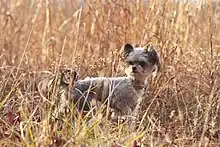Dog crossbreed
Dog crossbreeds, sometimes called designer dogs, are dogs which have been intentionally bred from two or more recognized dog breeds. They are not dogs with no purebred ancestors, but are not otherwise recognised as breeds in their own right, and do not necessarily breed true.
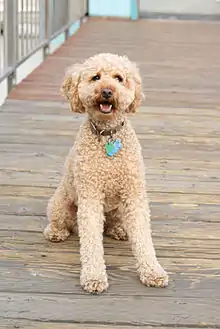
Dog crossbreeds are combinations of lineages of the domestic dog; they are distinguished from canid hybrids, which are interspecific crosses between Canis species (wolves, coyotes, jackals, etc.). Notable canid hybrids include the coydog, coywolf, dingo–dog hybrid, jackal–dog hybrid, and wolfdog.
Early crossbreeds
Several types of dog crossbreeds date from the 14th century or earlier, such as the lurcher or the longdog.
Historically, crosses between dogs of different types were more well accepted at a time when modern purebred breeds (based on the eugenics principles) did not yet exist.[1][2] These types of crosses were performed to aggregate qualities of two different types in the same dog or to perfect an already fixed type of dog, always for working purposes.[2] An example to be cited is the famous case of Lord Orford's Greyhounds, which were improved by adding courage through the crossing with Old English Bulldogs, achieving the desired result after six generations.[3][2] With the success of Lord Orford's dogs, the practice was adopted by other Greyhound breeders and became more common.
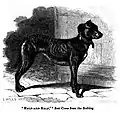 Greyhound/Old English Bulldog first cross
Greyhound/Old English Bulldog first cross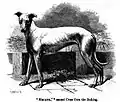 Greyhound/Old English Bulldog second cross
Greyhound/Old English Bulldog second cross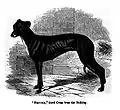 Greyhound/Old English Bulldog third cross
Greyhound/Old English Bulldog third cross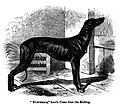 Greyhound/Old English Bulldog fourth cross
Greyhound/Old English Bulldog fourth cross
Other historical examples are the bull and terrier (Old English Bulldog and terrier cross) and crosses between foxhounds and Old Spanish Pointers[2] that later resulted in the English Pointer.
Designer dogs
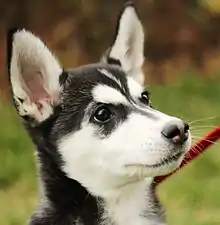
The Encyclopædia Britannica traces what was the "designer dog" fad to the late 20th century when breeders began to cross purebred Poodles with other purebred breeds to obtain a dog with the Poodle's hypoallergenic coat, along with various desirable characteristics from other breeds.[4]
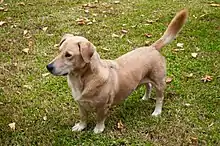
The resulting puppies are called by a portmanteau word made up of syllables (or sounds) from the breed names of the two purebred parents, such as Schnoodle (Schnauzer and Poodle cross),[4] or Shepsky (German Shepherd Dog/Siberian Husky cross). Other purebred breeds are being crossed to provide designer dogs described with an endless range of created labels, such as the Puggle (Pug and Beagle cross). There are even complex crosses (with multiple breeds in recent ancestry) being labeled in this manner, such as the German Chusky (German Shepherd Dog, Siberian Husky and Chow Chow cross).
Like children in a family, a percentage of designer dogs with the same breed ancestry will look similar to each other, even though crossbreeding does not result in as uniform a phenotype as the breeding of purebreds. Often even pups in the same litter will look quite different.
Another defining characteristic of designer dogs is that they are usually bred as companion dogs and pets. Working and hunting dogs deliberately crossbred for a particular working purpose are not generally given portmanteau names; they are most often referred to by a type name, such as Eurohounds (racing sled dogs) or lurchers (hunting dogs). These dogs could be considered only as crossbreeds, not as designer animals, since appearance is not the main reason for them to be bred. An exception to this is the Labradoodle, which although having a portmanteau name, is often used as a Guide or Assistance dog[5][6] as well as being a popular family dog.
Although designer dogs are often selected by owners for their novelty, reputable breeders sometimes use crossbreeding in an attempt to reduce the incidence of certain hereditary problems found in the purebred dogs, while retaining their more appealing traits. Jon Mooallem, writing in The New York Times, commented, "Given the roughly 350 inherited disorders littering the dog genome, crossing two purebreds and expanding their gene pools can be 'a phenomenally good idea,' according to one canine geneticist—if it is done conscientiously."[7] Crossbreeding has not been well studied in dogs, although it has been for livestock. The heritability of the desired trait being bred for (such as a hypoallergenic coat) needs to be known; "Heritability is the proportion of the measurable difference observed between animals for a given trait that is due to genetics (and can be passed to the next generation)."[8] In addition, the goals of dog crossbreeding may be harder to define than the goals of livestock crossbreeding; good temperament may be harder to define and measure than high calf weight.
Designer dog breeders are often criticised for being more interested in profitable puppy production than in dog health and welfare. Wally Conron, writing in Reader's Digest, comments on the popularity of crosses after his introduction of the Labradoodle: "Were breeders bothering to check their sires and bitches for heredity faults, or were they simply caught up in delivering to hungry customers the next status symbol?"[9]
'Designer dog' puppies sometimes bring higher prices than the purebreds from which they are bred.[10][11][12][13] Fanciers of designer dogs say that all modern dog breeds were created from earlier breeds and types of dogs through the same kind of selective breeding that is used to create designer dogs. The Toy Poodle was bred down in size from the larger Standard Poodle, most likely by crossing with various very small Bichon types, such as the Maltese and Havanese.[14] Most of the modern breeds have ancestries that include various older dog types and breeds; see individual breed articles for details of the origin of each breed.
Health of crossbred dogs depends on their being descended from healthy parents. Breeders who select their breeding stock for cost-effectiveness and who skip health testing for the same reason will not produce puppies that are as reliably healthy as those bred by more conscientious breeders. However, studies of longevity in dogs have found some advantage for crossbreeds compared to purebred dogs.[15] In general it is believed that crossbred dogs "have a far lower chance of exhibiting the disorders that are common with the parental breeds. Their genetic health will be substantially higher."[16]
Genetic defects
Crossbreeding that takes advantage of the increased chance that a recessive detrimental allele will only be inherited from one parent and therefore not expressed in the phenotype of the offspring,[17] is one strategy breeders can use to decrease the incidences of genetic defects. Knowing the disease incidence in the breed, and the genetic history of the individual, is important.
Registration and recognition

Crossbreed dogs are not recognized by traditional breed registries, even if both parents are registered purebreds. Breed associations such as the American Kennel Club, the United Kennel Club and the Canadian Kennel Club do not recognize designer crosses as dog breeds.
If crossbred dogs are bred together for some period of time, and their breeding is well documented, they may eventually be considered a new breed of dog by major kennel clubs (an example of a recent crossbreed becoming a breed recognised by all major kennel clubs is the Cesky Terrier). New breeds of dogs must have a breed club that will document the ancestry of any individual member of that breed from the original founding dogs of the breed; when the kennel club that the breed club wishes to join is satisfied that the dogs are pedigreed, they will accept and register the dogs of that breed. Each kennel club has individual rules about how to document a new breed. Some minor registries and internet registry businesses will register dogs as any breed the owner chooses with minimal or no documentation; some even allow the breeder or owner to make up a designer "breed name" for their pet.
Some crossbred dogs, created by breeding two purebred dogs of different breeds, may have the advantage of heterosis, or crossbreed vigor. This advantage can be progressively diluted when two crossbreeds are bred in the attempt to create a breed, narrowing the gene pool. The best way to continue taking advantage of crossbreed vigor is from the breeding of dogs of purebred ancestry, as this vigor is typically seen only in the first generation cross of two purebred animals of separate breeds, thus taking advantage of genetic diversity.[18]
See also
- Crossbreed, for any animal
- Dog type
- List of dog crossbreeds
- Puppy mill
- Purebred dog
References
- Brandow, Michael (2015). A Matter of Breeding: A Biting History of Pedigree Dogs and How the Quest for Status Has Harmed Man's Best Friend. Beacon Press. ISBN 9780807033432.
- Walsh, John Henry (1859). The dog, in health and disease, by Stonehenge.
- Dalziel, Hugh (1 August 2005). The Greyhound: Its History, Points, Breeding, Rearing, Training and Running. Read Books. ISBN 9781905124978.
- "Designer dog - mammal". Britannica.com. Retrieved 23 January 2018.
- "Colchester: More than puppy love!". Gazette-news.co.uk. 17 June 2008. Retrieved 31 May 2013.
- Altonn, Helen (28 June 2004). "What do you get when you breed Labradors with poodles? Labradoodles". Honolulu Star-Bulletin. Retrieved 31 May 2013 – via starbulletin.com.
- Mooallem, Jon (4 February 2007). "The Modern Kennel Conundrum". The New York Times.
- "Why Crossbreed?". Virginia Tech agricultural extension (cattle breeding). Archived from the original on 17 January 2009.
- Conron, Wally (August 9, 2010). "My Story: I Designed a Dog". Reader's Digest Magazine. pp. 28–30. Archived from the original on 24 July 2014.
- Bennett, Laura (December 10, 2007). "Pet Industry Trends for 2008". smallbiztrends.com. Archived from the original on 4 July 2008.
2008 will see the rapid growth of the puppy farm crossbreeds to take advantage of the inflated prices people are paying for these dogs.
- Patterson, Melissa (July 23, 2008). "Not all cute and cuddly in land of 'designer dogs,'". Chicago Tribune. Archived from the original on 6 October 2008.
[crossbreed designer dog puppies] often go for more money than purebreds, which can range from $200 to $2,000 per dog.
- Caesar, Ed (8 March 2007). "Hounded out: Fur and loathing in the dog world". The Independent.
the stampede to acquire one (designer dog) has become so furious that puppies now sell for as much as £2,000.
- "Designer Dogs are the Rage". designerdoggies.com. Archived from the original on 4 July 2008.
the Beagle is one of the lowest priced purebred dogs, yet the Puggle often sells for much more than the purebred Pug.
- "Diminutive dogs". Poodlehistory.org. Retrieved 23 January 2018.
- Michell, A. R. (27 November 1999). "Longevity of British breeds of dog and its relationships with-sex, size, cardiovascular variables and disease". Veterinary Record. 145 (22): 625–629. doi:10.1136/vr.145.22.625. PMID 10619607. S2CID 34557345.
- McGreevy, P D; Nicholas, F W (1 November 1999). "Some Practical Solutions to Welfare Problems in Dog Breeding". Animal Welfare. 8 (4): 329–341. doi:10.1017/S0962728600021965. S2CID 255889459.
- Birchler, James A.; Yao, Hong; Chudalayandi, Sivanandan (29 August 2006). "Unraveling the genetic basis of hybrid vigor". Proceedings of the National Academy of Sciences of the United States of America. 103 (35): 12957–12958. Bibcode:2006PNAS..10312957B. doi:10.1073/pnas.0605627103. PMC 1559732. PMID 16938847.
- Csányi, Vilmos (2005). If Dogs Could Talk. Translated by Richard E. Quandt (First American ed.). New York: North Point Press. pp. 285–286. ISBN 978-0-86547-686-8.
External links
- Mooallem, Jon (4 February 2007). "The Modern Kennel Conundrum". The New York Times Magazine.
- Much Ado About Poo at canismajor.com
